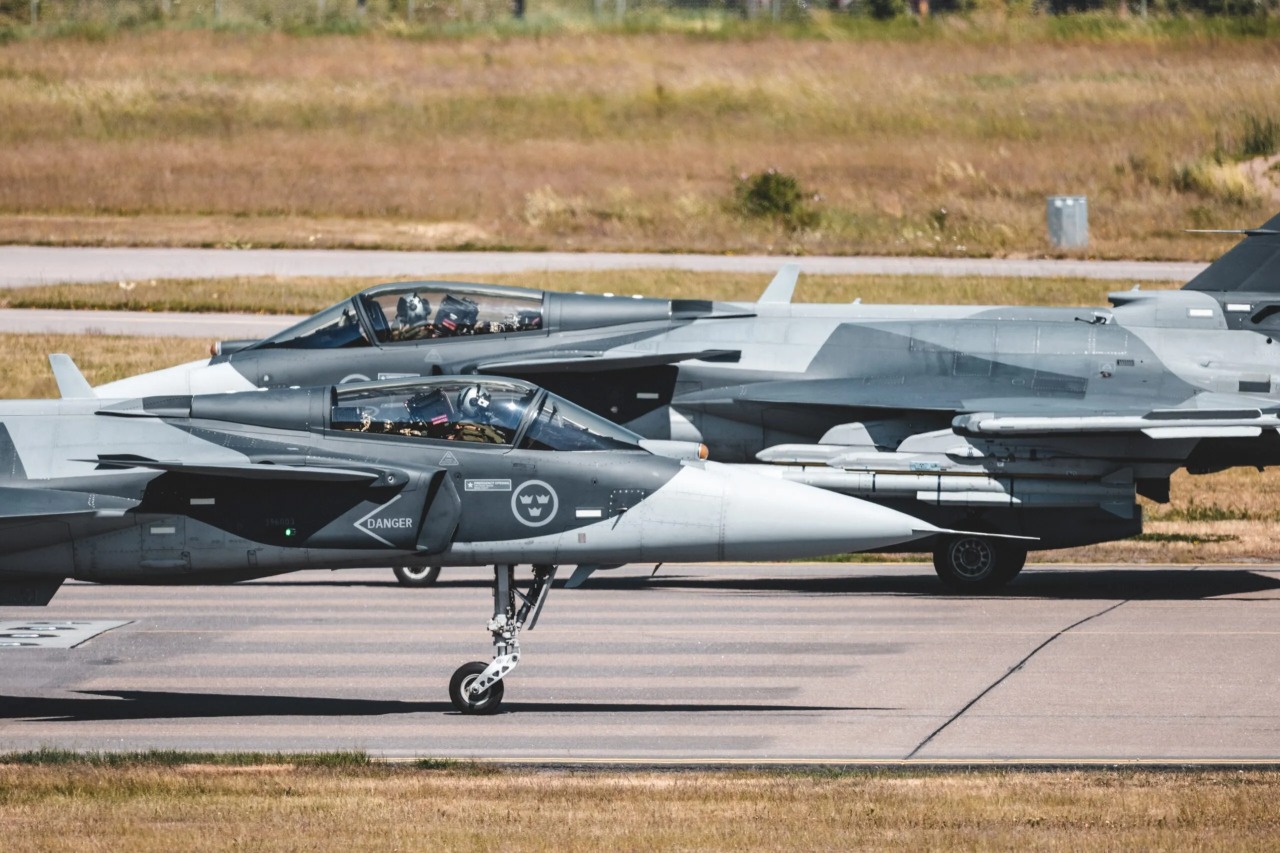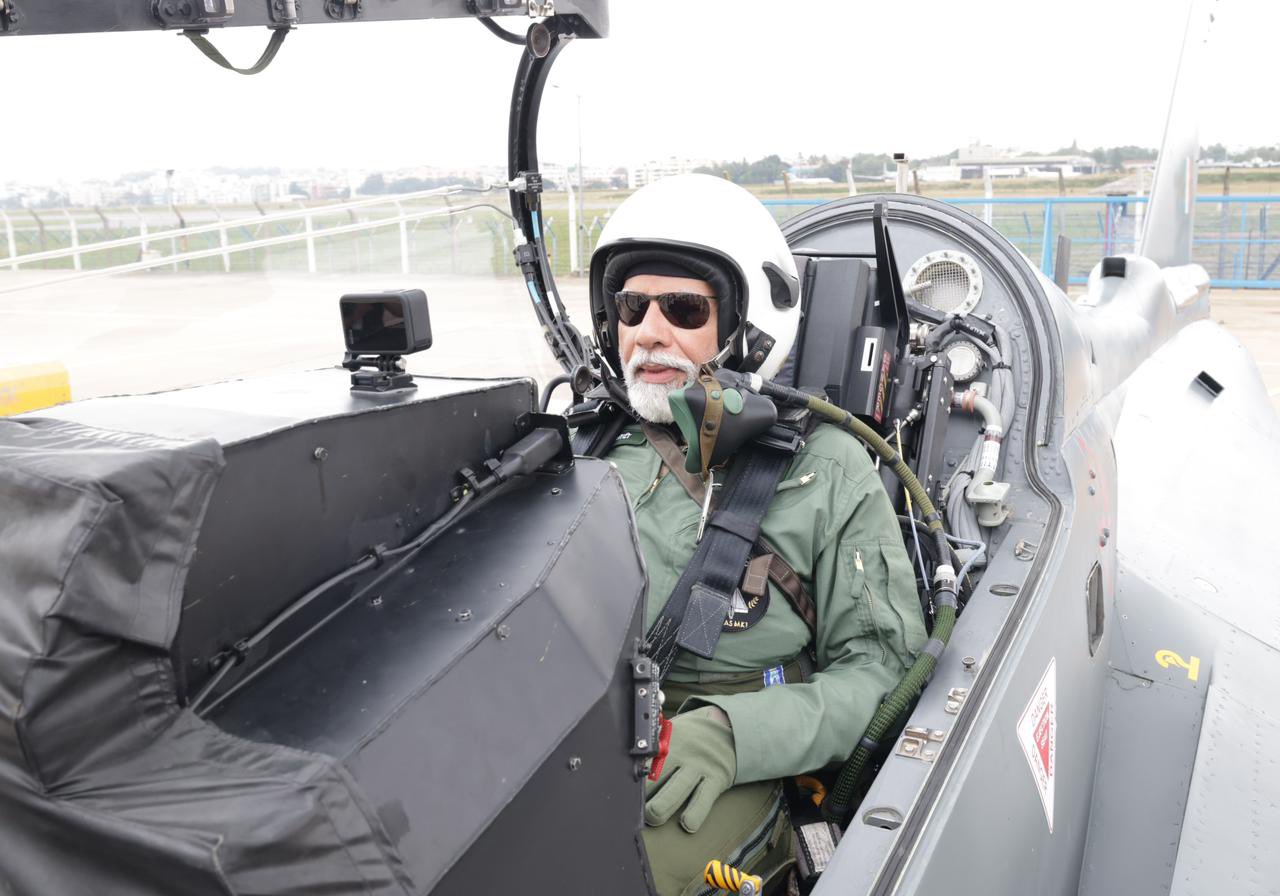After years of struggle, Saab has finally achieved a breakthrough by winning (unofficially) a major contract with the Royal Thai Air Force (RTAF) for Gripen E/F fighter jets.
This development marks a significant turnaround for the Swedish defense giant, signaling potential new opportunities, including a chance to compete for India’s highly anticipated multi-role fighter aircraft (MRFA) tender.
The Royal Thai Air Force announced on August 27 its intention to procure the Gripen E/F, citing the aircraft’s ability to meet the military’s strategic and doctrinal needs.
The RTAF noted that the decision came after a comprehensive evaluation process lasting ten months. This endorsement from the Thai Air Force is seen as a significant boost for Saab, which has struggled to secure contracts against formidable competitors in recent years.
Richard Smith, Deputy Head of Marketing & Sales for Gripen, expressed his satisfaction over the contract, stating, “Some more positive news for our #gripen team. After 4 Gripen Cs to #hunaf (Hungarian Air Force) – the Gripen E/F has now beaten off the F-16 to be selected by Thailand #säkpol @saab – we have a way to go, but RTAF is set to be the third E/F operator.”
Smith’s statement highlights the growing confidence in Gripen E/F’s capabilities and its emerging market presence. While the exact number of Gripen E/F fighters Thailand plans to acquire remains undisclosed, earlier reports suggest an immediate requirement for 12–14 new fighters.
The RTAF aims to initiate procurement in the 2025 fiscal year, with deliveries expected to begin by 2028. This makes Thailand the second export customer for the Gripen E/F after Brazil, which signed a $5.4 billion contract in 2014 for 36 aircraft, with an option for 72 more.
Thailand’s backing could signal a turning point for Saab, improving its chances in future competitions and attracting more buyers. One of the most coveted contracts Saab hopes to secure is India’s long-delayed $20 billion tender for 114 multi-role fighter aircraft.
Saab Gripen For Indian Air Force?
The Swedish aerospace and defense firm Saab is making notable progress in its efforts to secure the Indian Air Force’s (IAF) forthcoming tender for 114 Multi-Role Fighter Aircraft (MRFA).
This tender has gained importance as the number of fighter jet squadrons in the IAF continues to shrink, and fleet modernization is urgently required. Saab, known for its single-engine Gripen fighter jets, is positioning itself as a strong contender in this high-profile competition.
Forget J-20, China’s H-20 Stealth Bomber Threatens ‘Easy Penetration’ Of LAC; How Can IAF Respond?
The MRFA tender is a natural progression from the earlier Medium Multi-Role Combat Aircraft (MMRCA) deal, which was eventually scrapped in 2015.
The MMRCA initiative, spanning nearly 15 years, culminated in the Indian government’s decision to bypass the competitive bidding process and directly procure 36 Rafale aircraft from the French government.
This decision left a gap that the MRFA tender is now poised to fill, offering a second chance for global aircraft manufacturers to compete for one of the largest defense contracts in the world.
The Indian branch of Saab has been persistent, especially after the IAF issued a Request for Information (RFI) in 2018, which drew enthusiastic responses from aircraft manufacturers worldwide.
Despite the high level of interest, the competition has been marred by delays, and the process has lasted far longer than initially anticipated. As of late last year, reports indicated that while the IAF remains focused on the MRFA tender, it is awaiting a green light from the Indian government.
Saab faces formidable competition from competitors like Lockheed Martin, with its F-21 (some call it F-35, F-22 fusion), Boeing’s F-15EX, Dassault’s Rafale, Russia’s MiG-35 and Sukhoi-35, and the Eurofighter Typhoon.
US Pushes “F-22, F-35 Fusion” To Indian Air Force Under Make In India; Lockheed Boss Meets PM Modi
In recent years, Saab has presented compelling proposals to attract India’s interest. In the past, the Swedish defense giant proposed a full Transfer of Technology (ToT) and local production of its Gripen jets in India at a cost significantly lower than that of the Rafale, which is widely regarded as the frontrunner due to its existing presence in the IAF fleet.
Saab’s leadership highlighted that the Gripen comes equipped with a weapons package comparable to that of the Rafale, including the Meteor air-to-air missile, which has been tested extensively on the Gripen platform.
Ola Rignell, the Chairman and Managing Director of Saab India, pointed out that the Gripen has been successfully integrated with all NATO missiles except the French SCALP missile. Rignell confirmed that Saab could integrate the SCALP missile should India express interest, although the Gripen already includes a comparable alternative.
He further noted that European missile manufacturer MBDA, which produces the Meteor and SCALP missiles, selected the Gripen as the primary test platform for these weapons, underscoring the aircraft’s maturity and reliability.
Rignell further argued that Gripen’s single-engine configuration results in lower lifecycle costs compared to the twin-engine Rafale, making it a more cost-effective alternative for the IAF.
With these advantages, the Gripen is considered one of the top contenders in the MRFA competition, alongside the Rafale and Boeing’s F-15EX.
However, Rahul Manohar Yelwe, a Senior Research Fellow at the Center for Security Studies, shared with EurAsian Times that he believes the F-15EX is unlikely to secure the tender.
He reasoned that India already operates a large number of Russian Su-30 fighter jets, which serve as air superiority aircraft. From a strategic perspective, adding another aircraft of a similar category would not make sense.
How Capable Is Gripen E/F Aircraft?
The Gripen E is the latest iteration of the JAS 39 fighter jet and received its Military Restricted Type Certificate (MRTC) in November 2022, confirming its airworthiness for military operations. This advanced version has undergone extensive upgrades, positioning it as a strong competitor to aircraft like the Rafale.
The Gripen-E series boasts enhanced capabilities, including a more powerful engine, upgraded radar technology, and the capacity to carry greater payloads. Equipped with the Volvo RM12 afterburner turbo engine, the aircraft can reach speeds of Mach 2 and has a range of 932 miles.
The Gripen E has ten hardpoints, enabling it to carry a diverse range of weapons and pods. The aircraft boasts a rapid turnaround time, with just 10 minutes required for air-to-air missions and 20 minutes for air-to-ground engagements.
In addition, the internal fuel capacity has been increased by 40%, allowing the Gripen E to stay in the air longer than previous models.
The Gripen E’s cockpit has been completely redesigned with SAAB’s Human-Machine Collaboration concept, ensuring optimal interaction between the pilot and the aircraft. This includes a hands-on-throttle-and-stick (HOTAS) setup, which minimizes distractions and enhances situational awareness.
Information is displayed to the pilot through three Multi-Function Displays (MFDs), including the Wide Area Display, with a heads-up display integrated into the pilot’s visor. The system also incorporates Artificial Intelligence (AI) to deliver timely and relevant information.
The Gripen E is highly versatile and capable of carrying armaments for various mission types, including electronic warfare, air-to-air combat, and bombing runs. For air-to-air combat, the fighter jet can be armed with missiles such as AMRAAM, ASRAAM, IRIS-T, and Meteor.
Its air-to-surface arsenal includes GBU and Mk-series bombs, along with missiles like the AGM-65 Maverick and Taurus KEPD 350. This flexibility makes the Gripen E a formidable and adaptable fighter in modern combat scenarios.

Why IAF May Reject Saab Gripen?
Yelwe pointed out that the Gripen E is a highly capable fighter jet that aligns well with India’s requirements from both financial and technical perspectives.
He noted that the cost of a single Gripen fighter jet is approximately $80-85 million, making it a financially viable option for India. This relatively lower price point would enable India to procure a large number of these jets, enhancing its air combat capabilities without imposing a heavy financial burden.
Yelwe also highlighted the stark difference in operational costs between the Gripen and Rafale aircraft, stating, “The operating cost of a Gripen fighter jet is estimated to be between $4,000 to $5,000 per flight hour. In contrast, the operating cost of a Rafale fighter jet is estimated to be around $15,000 to $16,000 per flight hour.”
Although the Gripen E fighter jet possesses significant capabilities for success in contemporary combat scenarios, various factors reduce its likelihood of being chosen by the IAF.
Despite its advanced features, such as cutting-edge electronic warfare capabilities, integration of powerful missiles, a reduced radar cross-section, and low operating costs, the aircraft appears to be at a disadvantage compared to its rivals.
Previous reports from the EurAsian Times indicated that the Gripen E faces challenges mainly due to two critical factors: the lack of substantial political influence and inadequate financial support.
Dr. Atul Kumar, Fellow in National Security and China Studies at India-based Think Tank Observer Research Foundation, told EurAsian Times, “In terms of capability, the Gripen-E closely mirrors India’s single-engine Light Combat Aircraft (LCA). Both (Gripen and Tejas Mk2) are powered by similar engines and share comparable combat range and capabilities. The Indian Air Force is already inducting the LCA Mark 1, with more advanced variants in development, rendering the selection of the Gripen-E redundant.”

The Tejas is expected to become a core component of the IAF’s fleet, and its resemblance to the Gripen E raises questions about the need for another aircraft with similar capabilities.
Saab’s ambitious promises for the Gripen may not be enough to sway decision-makers who are already committed to developing and deploying the LCA Tejas.
Dr. Kumar pointed out another issue with the Gripen: “A major portion of the Gripen’s components are sourced from original equipment manufacturers (OEMs) in the US, Britain, and other European countries.”
“As a result, SAAB’s promise of technology transfer and local production in India is questionable. Without agreement from these OEMs, SAAB cannot genuinely offer to produce these crucial components in India, reducing the Indian production line to mere assembly. Since technology transfer is an essential criterion, the Gripen is unlikely to cross this bridge,” he said.
Similarly, Yelwe acknowledged that the Tejas and Gripen belong to the same category of aircraft; it makes no sense for the IAF to opt for these ‘very capable’ fighters. Buying Saab Gripen-E would mean killing India’s indigenous fighter program.
Nonetheless, Yelwe stressed that the MRFA tender cannot progress until the Indian government grants the Acceptance of Necessity (AoN), a crucial step in India’s defense procurement process.
- Contact the author at ashishmichel(at)gmail.com
- Follow EurAsian Times on Google News




